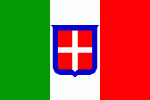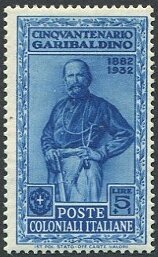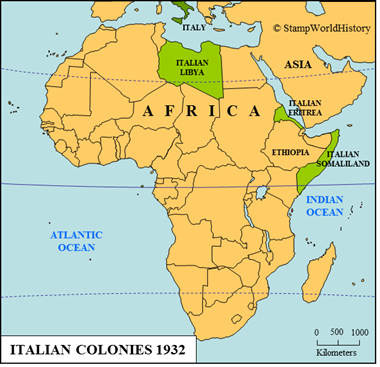
Italian colonies
Quick reference
General issues: Italian colonies 1932-1934
Country name on general issues: Colonie Italiane, Poste Coloniale Italiane
Currency: 1 Lira = 100 Centesimi
Political history Italian colonies
Only having become a united kingdom in 1861, Italy was late to join the European powers in the race for colonies. In the late 1860’s and the 1870’s, Italy establishes a presence in Eritrea and Somaliland. Eritrea becomes an Italian protectorate in 1888 and an Italian colony in 1890. Somaliland follows suit, becoming a protectorate in 1889 and a colony in 1905. The ultimate goal was the colonization of Ethiopia – an ambition that was thwarted, at this stage, by the defeat of Italy in the 1885-1886 Italo-Ethiopian war. Just prior to WWI, Italy, in 1911, engages the Ottoman Empire in the Italo-Turkish War. Italy comes out victorious and, in 1912, gains possession of Libya and the Aegean Islands[1]Also known as the Dodecanese. . Italian Libya is administratively divided into three parts: the colonies of Italian Cyrenaica and Italian Tripolitania and the Military Territory of Southern Libya – together known as both ‘Italian Libya’ and ‘Italian North Africa’. The Aegean Islands are administered as an Italian possession – a status different from that of a colony. Such is the extent of the Italian colonial empire in 1932.
Postal history Italian colonies

1932 – Portrait of Garibaldi from the Garibaldi issue. Garibaldi was one of leading men in the unification of Italy.
Between 1932 and 1934, Italy issues stamps for general use in the Italian colonies: Italian Eritrea, Italian Libya, and Italian Somaliland. The first set issued in 1932 is the Dante Society issue from Italy overprinted ‘Colonie Italiane’. The second set – also issued in 1932 – is the Garibaldi set from Italy, now inscribed ‘Poste coloniali Italiane’. Three subsequent sets are of designs specific for the Italian colonies. In 1934, the last set is issued – the Soccer World Cup set from Italy, again inscribed ‘Poste coloniali Italiane’. The large number of different stamps issued and the – maybe with the exception of the first set – relatively small print runs are reasons why it has been suggested that the stamps were issued as an attractive investment for collectors rather than for actual use in the Italian colonies.
Album pages
← Previous page: InhambaneNext page: Italian Cyrenaica →


